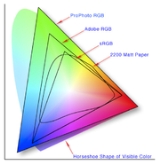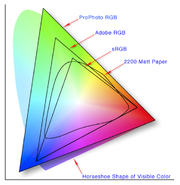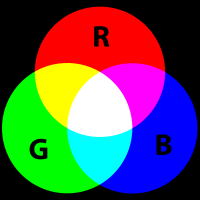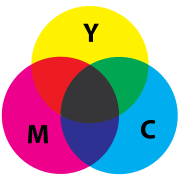
Color space
Encyclopedia

Color
Color or colour is the visual perceptual property corresponding in humans to the categories called red, green, blue and others. Color derives from the spectrum of light interacting in the eye with the spectral sensitivities of the light receptors...
s can be represented as tuple
Tuple
In mathematics and computer science, a tuple is an ordered list of elements. In set theory, an n-tuple is a sequence of n elements, where n is a positive integer. There is also one 0-tuple, an empty sequence. An n-tuple is defined inductively using the construction of an ordered pair...
s of numbers, typically as three or four values or color components (e.g. RGB
RGB color model
The RGB color model is an additive color model in which red, green, and blue light is added together in various ways to reproduce a broad array of colors...
and CMYK
CMYK color model
The CMYK color model is a subtractive color model, used in color printing, and is also used to describe the printing process itself. CMYK refers to the four inks used in some color printing: cyan, magenta, yellow, and key...
are color models). However, a color model with no associated mapping function to an absolute color space
Absolute color space
In color science, there are two meanings of the term absolute color space:* A color space in which the perceptual difference between colors is directly related to distances between colors as represented by points in the color space....
is a more or less arbitrary color system with no connection to any globally understood system of color interpretation.
Adding a certain mapping function between the color model and a certain reference color space results in a definite "footprint" within the reference color space. This "footprint" is known as a gamut
Gamut
In color reproduction, including computer graphics and photography, the gamut, or color gamut , is a certain complete subset of colors. The most common usage refers to the subset of colors which can be accurately represented in a given circumstance, such as within a given color space or by a...
, and, in combination with the color model, defines a new color space. For example, Adobe RGB
Adobe RGB color space
The Adobe RGB color space is an RGB color space developed by Adobe Systems in 1998. It was designed to encompass most of the colors achievable on CMYK color printers, but by using RGB primary colors on a device such as the computer display...
and sRGB
SRGB color space
sRGB is a standard RGB color space created cooperatively by HP and Microsoft in 1996 for use on monitors, printers, and the Internet.sRGB uses the ITU-R BT.709 primaries, the same as are used in studio monitors and HDTV, and a transfer function typical of CRTs...
are two different absolute color space
Absolute color space
In color science, there are two meanings of the term absolute color space:* A color space in which the perceptual difference between colors is directly related to distances between colors as represented by points in the color space....
s, both based on the RGB model.
In the most generic sense of the definition above, color spaces can be defined without the use of a color model. These spaces, such as Pantone
Pantone
Pantone Inc. is a corporation headquartered in Carlstadt, New Jersey, USA. The company is best known for its Pantone Matching System , a proprietary color space...
, are in effect a given set of names or numbers which are defined by the existence of a corresponding set of physical color swatches. This article focuses on the mathematical model concept.
Understanding the concept
A wide range of colors can be created by the primary colorsPrimary Colors
Primary Colors: A Novel of Politics is a roman à clef, a work of fiction that purports to describe real life characters and events — namely, Bill Clinton's first presidential campaign in 1992...
of pigment (cyan
Cyan
Cyan from , transliterated: kýanos, meaning "dark blue substance") may be used as the name of any of a number of colors in the blue/green range of the spectrum. In reference to the visible spectrum cyan is used to refer to the color obtained by mixing equal amounts of green and blue light or the...
(C), magenta
Magenta
Magenta is a color evoked by light stronger in blue and red wavelengths than in yellowish-green wavelengths . In light experiments, magenta can be produced by removing the lime-green wavelengths from white light...
(M), yellow
Yellow
Yellow is the color evoked by light that stimulates both the L and M cone cells of the retina about equally, with no significant stimulation of the S cone cells. Light with a wavelength of 570–590 nm is yellow, as is light with a suitable mixture of red and green...
(Y), and black
Black
Black is the color of objects that do not emit or reflect light in any part of the visible spectrum; they absorb all such frequencies of light...
(K)). Those colors then define a specific color space. To create a three-dimensional representation of a color space, we can assign the amount of magenta color to the representation's X axis, the amount of cyan to its Y axis, and the amount of yellow to its Z axis. The resulting 3-D space provides a unique position for every possible color that can be created by combining those three pigments.
However, this is not the only possible color space. For instance, when colors are displayed on a computer monitor, they are usually defined in the RGB (red
Red
Red is any of a number of similar colors evoked by light consisting predominantly of the longest wavelengths of light discernible by the human eye, in the wavelength range of roughly 630–740 nm. Longer wavelengths than this are called infrared , and cannot be seen by the naked eye...
, green
Green
Green is a color, the perception of which is evoked by light having a spectrum dominated by energy with a wavelength of roughly 520–570 nanometres. In the subtractive color system, it is not a primary color, but is created out of a mixture of yellow and blue, or yellow and cyan; it is considered...
and blue
Blue
Blue is a colour, the perception of which is evoked by light having a spectrum dominated by energy with a wavelength of roughly 440–490 nm. It is considered one of the additive primary colours. On the HSV Colour Wheel, the complement of blue is yellow; that is, a colour corresponding to an equal...
) color space. This is another way of making nearly the same colors (limited by the reproduction medium, such as the phosphor (CRT) or filters and backlight (LCD)), and red, green and blue can be considered as the X, Y and Z axes. Another way of making the same colors is to use their Hue
Hue
Hue is one of the main properties of a color, defined technically , as "the degree to which a stimulus can be describedas similar to or different from stimuli that are described as red, green, blue, and yellow,"...
(X axis), their Saturation
Saturation (color theory)
In colorimetry and color theory, colorfulness, chroma, and saturation are related but distinct concepts referring to the perceived intensity of a specific color. Colorfulness is the degree of difference between a color and gray. Chroma is the colorfulness relative to the brightness of another color...
(Y axis), and their brightness
Brightness
Brightness is an attribute of visual perception in which a source appears to be radiating or reflecting light. In other words, brightness is the perception elicited by the luminance of a visual target...
Value (Z axis). This is called the HSV color space. Many color spaces can be represented as three-dimensional (X,Y,Z) values in this manner, but some have more, or fewer dimensions, and some, such as Pantone, cannot be represented in this way at all.
Conversion
Color space conversion is the translation of the representation of a color from one basis to another. This typically occurs in the context of converting an image that is represented in one color space to another color space, the goal being to make the translated image look as similar as possible to the original.Density
The RGB color model is implemented in different ways, depending on the capabilities of the system used. By far the most common general-used incarnation is the 24-bitBit
A bit is the basic unit of information in computing and telecommunications; it is the amount of information stored by a digital device or other physical system that exists in one of two possible distinct states...
implementation, with 8 bits, or 256 discrete levels of color per channel
Channel (digital image)
Color digital images are made of pixels, and pixels are made of combinations of primary colors. A channel in this context is the grayscale image of the same size as a color image, made of just one of these primary colors. For instance, an image from a standard digital camera will have a red, green...
. Any color space based on such a 24-bit RGB model is thus limited to a range of 256×256×256 ≈ 16.7 million colors. Some implementations use 16 bits per component for 48 bits total, resulting in the same gamut
Gamut
In color reproduction, including computer graphics and photography, the gamut, or color gamut , is a certain complete subset of colors. The most common usage refers to the subset of colors which can be accurately represented in a given circumstance, such as within a given color space or by a...
with a larger number of distinct colors. This is especially important when working with wide-gamut color spaces (where most of the more common colors are located relatively close together), or when a large number of digital filtering algorithms are used consecutively. The same principle applies for any color space based on the same color model, but implemented in different bit depths
Color depth
In computer graphics, color depth or bit depth is the number of bits used to represent the color of a single pixel in a bitmapped image or video frame buffer. This concept is also known as bits per pixel , particularly when specified along with the number of bits used...
.
Partial list of color spaces
CIE 1931 XYZ color spaceCIE 1931 color space
In the study of color perception, one of the first mathematically defined color spaces is the CIE 1931 XYZ color space, created by the International Commission on Illumination in 1931....
was one of the first attempts to produce a color space based on measurements of human color perception (earlier efforts were by James Clerk Maxwell
James Clerk Maxwell
James Clerk Maxwell of Glenlair was a Scottish physicist and mathematician. His most prominent achievement was formulating classical electromagnetic theory. This united all previously unrelated observations, experiments and equations of electricity, magnetism and optics into a consistent theory...
, König & Dieterici, and Abney at Imperial College) and it is the basis for almost all other color spaces. Derivatives of the CIE XYZ space include CIELUV, CIEUVW, and CIELAB.
Generic color models


RGB color space
An RGB color space is any additive color space based on the RGB color model. A particular RGB color space is defined by the three chromaticities of the red, green, and blue additive primaries, and can produce any chromaticity that is the triangle defined by those primary colors...
uses additive color
Additive color
An additive color model involves light emitted directly from a source or illuminant of some sort. The additive reproduction process usually uses red, green and blue light to produce the other colors. Combining one of these additive primary colors with another in equal amounts produces the...
mixing, because it describes what kind of light needs to be emitted to produce a given color. Light is added together to create form from out of the darkness. RGB stores individual values for red, green and blue. RGBA
RGBA color space
RGBA stands for Red Green Blue Alpha. While it is sometimes described as a color space, it is actually simply a use of the RGB color model, with extra information. The color is RGB, and may belong to any RGB color space, but an integral alpha value as invented by Catmull and Smith between 1971 and...
is RGB with an additional channel, alpha, to indicate transparency.
Common color spaces based on the RGB model include sRGB, Adobe RGB
Adobe RGB color space
The Adobe RGB color space is an RGB color space developed by Adobe Systems in 1998. It was designed to encompass most of the colors achievable on CMYK color printers, but by using RGB primary colors on a device such as the computer display...
and ProPhoto RGB
ProPhoto RGB color space
The ProPhoto RGB color space, also known as ROMM RGB , is an output referred RGB color space developed by Kodak. It offers an especially large gamut designed for use with photographic output in mind...
.
CMYK uses subtractive color
Subtractive color
A subtractive color model explains the mixing of paints, dyes, inks, and natural colorants to create a full range of colors, each caused by subtracting some wavelengths of light and reflecting the others...
mixing used in the printing process, because it describes what kind of inks need to be applied so the light reflected from the substrate
Substrate (printing)
Substrate is a term used in converting process such as printing and Lamination or coating as a more general term to describe the base material onto which e.g. images will be printed and to be laminated as per the packing specification required for the product...
and through the inks produces a given color. One starts with a white substrate (canvas, page, etc.), and uses ink to subtract color from white to create an image. CMYK stores ink values for cyan, magenta, yellow and black. There are many CMYK color spaces for different sets of inks, substrates, and press characteristics (which change the dot gain or transfer function for each ink and thus change the appearance).
YIQ
YIQ
YIQ is the color space used by the NTSC color TV system, employed mainly in North and Central America, and Japan. It is currently in use only for low-power television stations, as full-power analog transmission was ended by the U.S. Federal Communications Commission on 12 June 2009...
was formerly used in NTSC
NTSC
NTSC, named for the National Television System Committee, is the analog television system that is used in most of North America, most of South America , Burma, South Korea, Taiwan, Japan, the Philippines, and some Pacific island nations and territories .Most countries using the NTSC standard, as...
(North America, Japan and elsewhere) television broadcasts for historical reasons. This system stores a luminance value with two chrominance values, corresponding approximately to the amounts of blue and red in the color. It is similar to the YUV
YUV
YUV is a color space typically used as part of a color image pipeline. It encodes a color image or video taking human perception into account, allowing reduced bandwidth for chrominance components, thereby typically enabling transmission errors or compression artifacts to be more efficiently...
scheme used in most video capture systems and in PAL
PAL
PAL, short for Phase Alternating Line, is an analogue television colour encoding system used in broadcast television systems in many countries. Other common analogue television systems are NTSC and SECAM. This page primarily discusses the PAL colour encoding system...
(Australia, Europe, except France, which uses SECAM
SECAM
SECAM, also written SÉCAM , is an analog color television system first used in France....
) television, except that the YIQ color space is rotated 33° with respect to the YUV color space. The YDbDr
YDbDr
YDbDr, sometimes written YDBDR, is the colour space used in the SÉCAM analog terrestrial colour television broadcasting standard, which is used in France and some countries of the former Eastern Bloc. It is very close to YUV and its related colour spaces such as YIQ , YPbPr and YCbCr.YDbDr is...
scheme used by SECAM
SECAM
SECAM, also written SÉCAM , is an analog color television system first used in France....
television is rotated in another way.
YPbPr
YPbPr
' is a color space used in video electronics, in particular in reference to component video cables. is the analog version of the YCBCR color space; the two are numerically equivalent, but YPBPR is designed for use in analog systems whereas YCBCR is intended for digital video. cables are also...
is a scaled version of YUV. It is most commonly seen in its digital form, YCbCr
YCbCr
YCbCr or Y′CbCr, sometimes written or , is a family of color spaces used as a part of the color image pipeline in video and digital photography systems. Y′ is the luma component and CB and CR are the blue-difference and red-difference chroma components...
, used widely in video and image compression
Image compression
The objective of image compression is to reduce irrelevance and redundancy of the image data in order to be able to store or transmit data in an efficient form.- Lossy and lossless compression :...
schemes such as MPEG and JPEG
JPEG
In computing, JPEG . The degree of compression can be adjusted, allowing a selectable tradeoff between storage size and image quality. JPEG typically achieves 10:1 compression with little perceptible loss in image quality....
.
xvYCC
XvYCC
xvYCC or Extended-gamut YCC is a color space that can be used in the video electronics of television sets to support a gamut 1.8 times as large as that of the sRGB color space...
is a new international digital video color space standard published by the IEC
International Electrotechnical Commission
The International Electrotechnical Commission is a non-profit, non-governmental international standards organization that prepares and publishes International Standards for all electrical, electronic and related technologies – collectively known as "electrotechnology"...
(IEC 61966-2-4). It is based on the ITU BT.601 and BT.709
Rec. 709
ITU-R Recommendation BT.709, more commonly known by the abbreviations Rec. 709 or BT.709, standardizes the format of high-definition television, having 16:9 aspect ratio. The first edition of the standard was approved in 1990....
standards but extends the gamut beyond the R/G/B primaries specified in those standards.
HSV (hue, saturation, value), also known as HSB (hue, saturation, brightness) is often used by artists because it is often more natural to think about a color in terms of hue and saturation than in terms of additive or subtractive color components. HSV is a transformation of an RGB colorspace, and its components and colorimetry are relative to the RGB colorspace from which it was derived.
HSL
HSL color space
HSL and HSV are the two most common cylindrical-coordinate representations of points in an RGB color model, which rearrange the geometry of RGB in an attempt to be more intuitive and perceptually relevant than the cartesian representation...
(hue, saturation, lightness/luminance), also known as HLS or HSI (hue, saturation, intensity) is quite similar to HSV, with "lightness" replacing "brightness". The difference is that the brightness of a pure color is equal to the brightness of white, while the lightness of a pure color is equal to the lightness of a medium gray.
Commercial color spaces
- Munsell color systemMunsell color systemIn colorimetry, the Munsell color system is a color space that specifies colors based on three color dimensions: hue, value , and chroma . It was created by Professor Albert H...
- Natural Color System (NCS)Natural Color SystemThe Natural Color System is a proprietary perceptual color model published by the Scandinavian Colour Institute of Stockholm, Sweden. It is based on the color opponency description of color vision, first proposed by German physiologist Ewald Hering...
Special-purpose color spaces
- The RG Chromaticity space is used in Computer visionComputer visionComputer vision is a field that includes methods for acquiring, processing, analysing, and understanding images and, in general, high-dimensional data from the real world in order to produce numerical or symbolic information, e.g., in the forms of decisions...
applications. It shows the color of light (red, yellow, green etc.), but not its intensity (dark, bright).
Obsolete color spaces
Early color spaces had two components. They largely ignored blue light because the added complexity of a 3-component process provided only a marginal increase in fidelity when compared to the jump from monochrome to 2-component color.- RGRG color spaceThe RG or red-green color space is a color space that uses only two colors, red and green. It is an additive format, similar to the RGB color model but without a blue channel. Thus, blue is said to be out of gamut...
for early TechnicolorTechnicolorTechnicolor is a color motion picture process invented in 1916 and improved over several decades.It was the second major process, after Britain's Kinemacolor, and the most widely used color process in Hollywood from 1922 to 1952...
film - RGK for early color printing
External links
- Color FAQ, Charles Poynton
- FAQ about color physics, Stephen Westland
- Color Science, Dan Bruton
- Color Spaces, Rolf G. Kuehni (October 2003)
- Colour spaces - perceptual, historical and applicational background, Marko Tkalčič (2003)
- Color formats for image and video processing - Color conversion between RGB, YUV, YCbCr and YPbPr.
- C library of SSE-optimised color format conversions.
- Konica Minolta Sensing: Precise Color Communication

